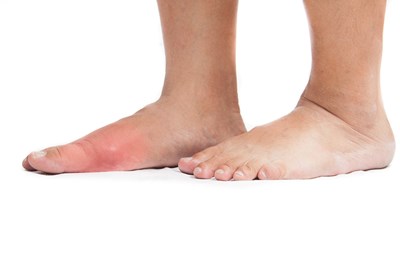Gout is a condition in which excessive amounts of uric acid build up, creating sharp urate crystals in the joints or surrounding tissue. The crystals cause episodes of sharp pain which gradually subside into long-lasting discomfort.
Although the big toe is the most common joint for gout pain, it may also present in the other toes, ankles, knees, fingers, wrists, and elbows. For some folks, gout can be a recurring battle. Luckily, there are multiple options for the treatment of gout and managing the condition.
Symptomatic Treatment of Gout
When treating gout, it is generally necessary to treat not only the underlying cause but also the pain associated with the buildup of urate crystals. Over-the-counter nonsteroidal anti-inflammatories (NSAIDs), such as ibuprofen or naproxen, may be sufficient in some cases. However, stronger NSAIDs are also available by prescription. A stronger beginning dose followed by smaller amounts as the pain becomes controlled is not uncommon.
Colchicine is a prescription anti-inflammatory especially useful for managing the pain of gout. Unfortunately, it can cause extreme stomach problems, making it less useful. Small doses are often used for preventing future occurrences. When neither of these options is appropriate, oral or injectable corticosteroids may provide relief by managing pain and inflammation as well.
Other helpful options for the home treatment of gout, recommended by the Arthritis Foundation, include:
- Applying ice
- Elevating the affected joint
- Avoiding alcohol and soda
- Minimizing high-purine food intake, like steak and seafood
- Staying hydrated
- Managing stress
- Treating the affected joint gently
Treating Excessive Uric Acid from Gout
When treating the amount of uric acid in the blood from gout, it’s important to know if there really is too much. In some cases, the body produces an excessive amount. In others, the kidneys simply cannot appropriately filter out a normal amount of uric acid. These conditions may not be necessarily related to gout.
In the first case, xanthine oxidase inhibitors may be used to limit the amount of uric acid that the body actually makes to get production under control. The alternative is to try uricosuric agents, such as probenecid, which helps the kidneys to filter uric acid more efficiently. Either of these prescription medications can help prevent not only gout attacks, but also other complications that can arise from excessive uric acid in the blood, such as kidney stones. They can also be used as an option for the treatment of gout outbreaks.
If other medication treatment of gout doesn't work, Pegloticase may be used. This medication is fast-acting and brings uric acid levels lower than other options. According to the Arthritis Foundation, it requires an intravenous infusion every two weeks for efficaciousness.
Every medication, over-the-counter or otherwise, comes with potential side effects. Discuss all your options with your doctor to help choose the right course of treatment of gout for you.




